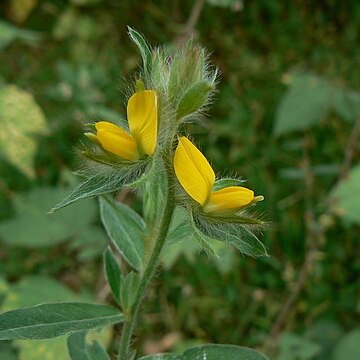Herbs, annual or short-lived perennial, erect, 30-80 cm tall. Branches terete, densely coarsely pilose. Stipules filiform, ca. 1 mm, persistent or caducous. Leaves simple, subsessile; leaf blade oblong-linear to linear-lanceolate, 3-12 × 0.5-1.5 cm, abaxially densely brownish pilose, adaxially pilose on midvein, base narrow, apex acute. Racemes terminal, usually condensed or headlike, 3-12-flowered, often with solitary axillary flowers below; bracts lanceolate, slightly ovate-falcate, 1-2 cm. Pedicel 2-4 mm, thick; bracteoles inserted at base of calyx tube or on middle or apical part of pedicel, similar to bracts but shorter. Calyx 2-lipped, 2-3 cm, parted to base, abaxially brownish pilose; lobes lanceolate. Corolla yellow, included in calyx; standard obovate to suborbicular, 1.5-2.5 cm, base with 2 appendages, apically pubescent; wings narrowly elliptic, ± as long as standard; keel with a long straight shortly twisted beak. Legume black when mature, subcylindric, 2-2.5 cm, 20-30-seeded, glabrous. Fl. Jun-Sep, fr. Oct-Dec.
An erect or spreading herb. It grows each year from seeds. It grows 30 cm to 1 m high. The leaves are simple and with short stalks. The leaf blade is narrow and 3-12 cm long by about 1 cm wide. The flowers are at the top. There are 3-12 flowers in a group. There can be flowers occurring singly in the axils of the leaves below. The flowers are pea like and pale yellow. The fruit is a black pod 2-3 cm long with 20-30 seeds.
Leaves simple; blade 4–15 × 0.4–1.5 cm, linear to oblong-lanceolate, acute, glabrous except along midvein above, appressed pilose beneath; petiole 1–4 mm long; stipules very small, obscured by indumentum.
Calyx 2–2.3 cm long, accrescent, longer than the corolla, deeply divided into 2 lips, densely covered with long tawny spreading hairs; upper lobes oblong-lanceolate, 3–4 times as long as the tube.
Standard elliptic-oblong, pale yellow, with a few hairs apically outside; wings nearly as long as the keel; keel 1.5–1.7 cm long, subangular, with a straight twisted beak.
Flowers few in terminal racemes and in the upper axils; bracts 6–18 mm long, lanceolate, caudate; bracteoles near the top of the pedicel, similar.
Erect annual, 0.15–1 m tall, usually little branched; stem densely covered with long coarse mostly appressed hairs.
Flowers yellow, few, about 1 in. long, enclosed by the conspicuously villous calyx
Seeds 2.5–3 mm long, subtriangular, shiny, smooth, pale yellow to light brown.
Pod sessile, 2–2.5 cm long, subcylindrical, glabrous, 16–36-seeded.
Erect annual herb, up to 2 ft. high, simple or with few branches
Densely brown-silky

